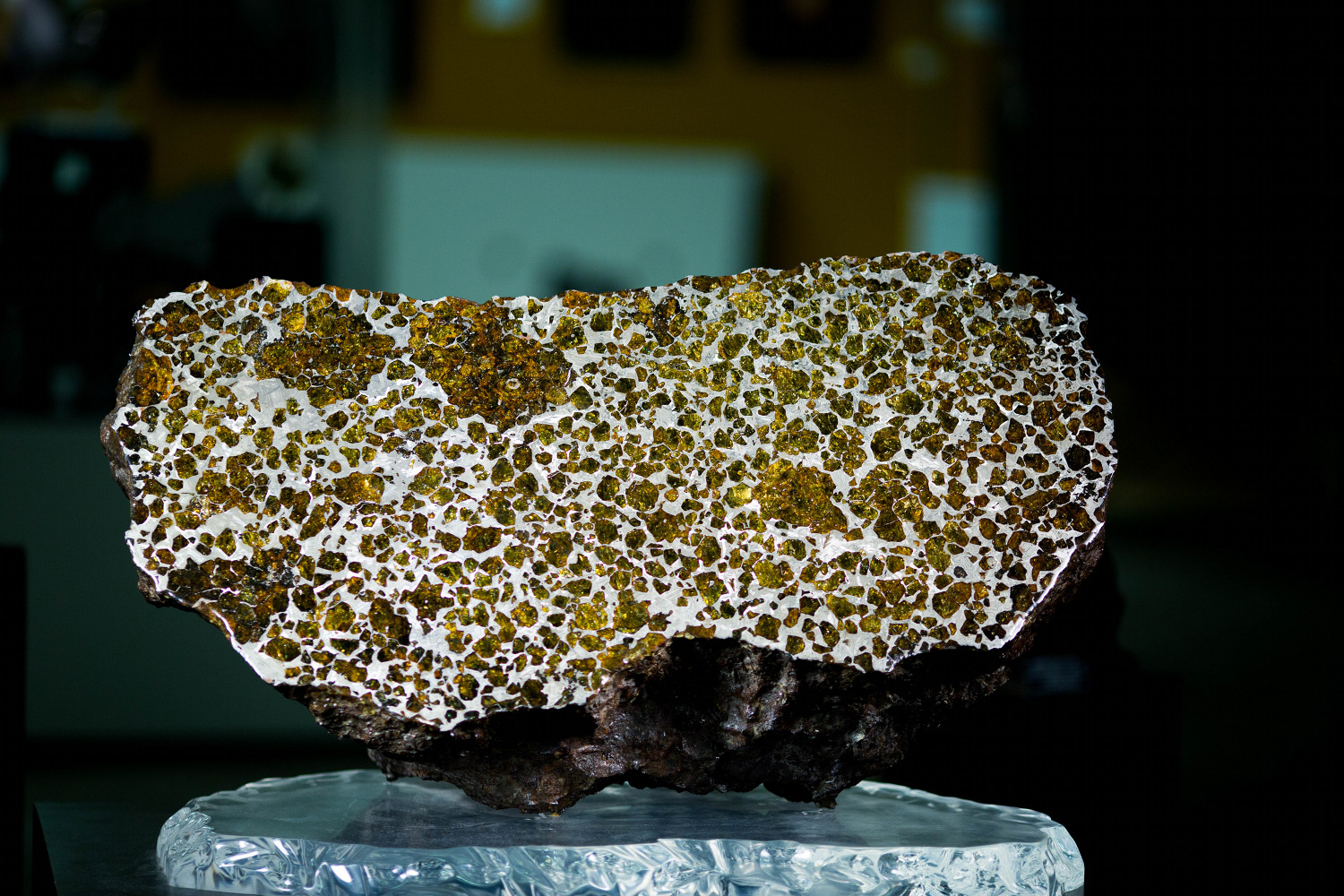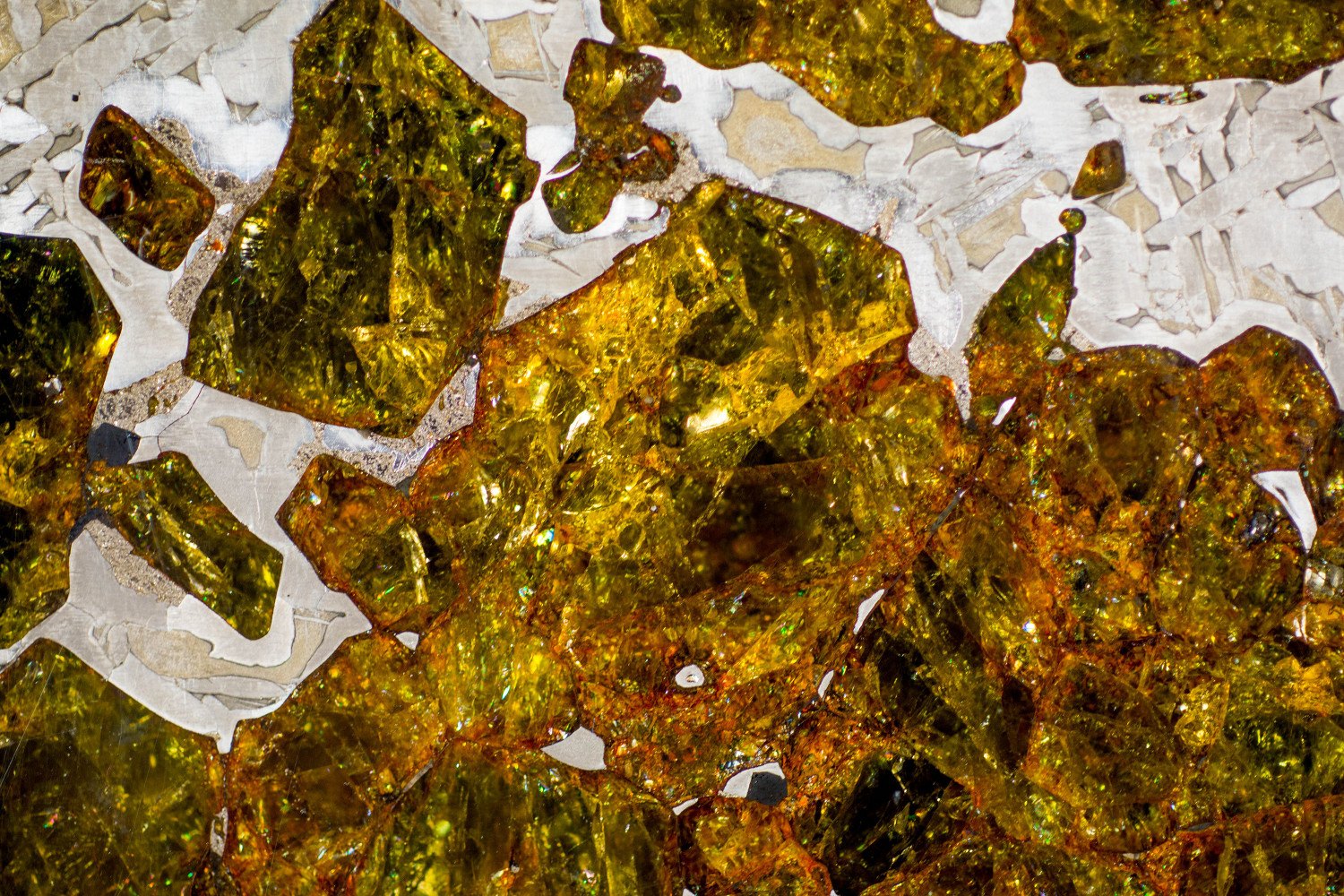Fukang Pallasite: One of the Rarest Types of Meteorite
This rare type of meteorite offers insight into asteroid formation, as well as earth’s geologic processes.

The Fukang pallasite at the Lunar and Planetary Laboratory at the University of Arizona. Copyright 2014 Symeon Platts/Arizona Board of Regents
Cut off a thin slice of the dazzling Fukang pallasite (a type of meteorite), and its green chunks—a mineral called olivine—shine like stained glass when held up to light.
“It’s absolutely gorgeous. It’s really a beautiful meteorite,” says Dante Lauretta, professor of planetary science in the Lunar and Planetary Laboratory at the University of Arizona, where a large hunk of the Fukang pallasite is on display.
Discovered in 2000 in China’s Gobi Desert near the town of Fukang, the rock in its entirety originally weighed about a ton, making it one of the largest and heaviest pallasite masses ever encountered, according to Lauretta. It was subsequently cut in half, with one portion going into the commercial meteorite market—“if you go to a gem and mineral show and you see a pallasite, there’s a good chance it’ll be Fukang,” says Lauretta—and the other to a buyer who has loaned it to the University of Arizona (a small piece of that is reserved for research, and the rest is on display).
Pallasites are a rare type of meteorite. The Meteoritical Society’s meteor database shows only 99 records of pallasites found on earth, according to Lauretta (for comparison, the most common type of meteorite, the chondrite, has 43,750 records). There are a few theories about where in an asteroid pallasites form, but the leading theory suggests that they originate where an asteroid’s mantle meets its core, because they contain both the silicate material of a mantle and the metallics of a core (the olivine grains are surrounded by an iron- and nickel-based metal).
By studying pallasites like Fukang, “we can start to understand processes deep inside the interiors of asteroids and how those asteroids evolved and melted in the earliest stages of the geology of our solar system,” says Lauretta. “But the [Fukang pallasite] also gives us insight into what might be happening deep in the interior of our own planet.”

What differentiates Fukang from all other known meteorites, and even pallasites, is the presence of a mineral called tridymite in small inclusions within the olivine, says Daniella DellaGiustina, a scientist at the Lunar and Planetary Laboratory who has also done research on Fukang. Tridymite, she explains, is similar to quartz but has a different crystalline structure, and doesn’t typically coexist with the type of olivine that predominates in Fukang, which is rich in magnesium. The two minerals form under very different pressure, temperature, and chemical conditions, she says, so it’s unusual that they could occur together.
“Having these two things that should form in very different situations—one encapsulated into another—it tells us that if [some environmental factor] changed, it had to change very quickly,” DellaGiustina says. “It’s the sort of thing that makes you scratch your head.”
The researchers hypothesize that the pallasite might have undergone a “reheating” stage, whereby molten metal was somehow injected into the olivine that had formed in the asteroid, causing the olivine to rapidly heat up. The tridymite might have subsequently crystallized out of melted portions of olivine.
DellaGiustina says her team also found another mineral in microscopic inclusions in the Fukang pallasite that scientists so far have been unable to identify. The composition is similar to that of a garnet, but X-ray diffraction measurements were inconclusive. “We were never able to determine what the actual crystalline structure was,” DellaGiustina says. “So it could be a new mineral, for all we know.”
The Lunar Planetary Laboratory scientists hope they’ll be able to learn more about this mineral, as well as trace the origins of the tridymite, pending more research funding. Perhaps then they’ll uncover even more mysteries to Fukang than first meet the eye.
Chau Tu is an associate editor at Slate Plus. She was formerly Science Friday’s story producer/reporter.